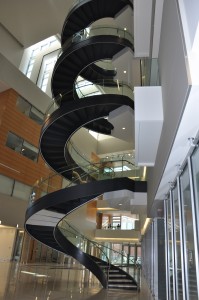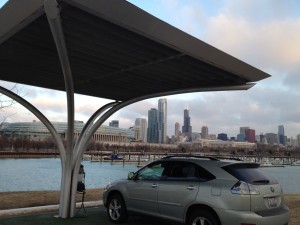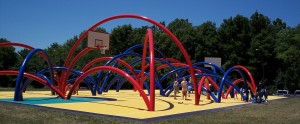Next week the National Ornamental & Miscellaneous Metals Association (NOMMA) will hold their annual national convention, Metalfab 2014, at the St. Charles Convention Center in St. Charles, MO (near St. Louis). For those not familiar with what its 600 members do, let me try to describe their wide range of products and methods of fabrication.
In the arena of commercial and institutional construction, their members contribute to a wide range of building construction components — almost every type of metal used in construction except the primary structural elements of the building. So . . . miscellaneous metal fabricators do not provide the framing of a building. They supply the stair systems, the railings, the balconies, the fencing, the gates, the grilles, the light fixtures, the furniture, the decorative structural steel, and hundred of miscellaneous architectural components including art work.
The methods of these artisans are also very varied. They include casting, machining, forming, cutting, welding, drilling, forging, and even blacksmithing. (A blacksmith shapes objects from wrought iron or steel by using tools to hammer, bend or cut them after heating them red-hot – it’s a type of forging.)
Members of the National Ornamental & Miscellaneous Metals Association have varying capabilities and often turn to outside companies for products or services to complete their projects. Standard architectural elements like grilles, finials, hand rails, etc. can be purchased through catalogues. The members typically self-perform welding and assembly. And they often install the fabricated material.
Based on the machinery suppliers who advertise in NOMMA’s Ornamental & Miscellaneous Fabricator Magazine, I believe that many members use small machines – some even hand-operated – to craft their works. Small rolling machines are used to create spirals, twisted members, and other curved shapes. But as the sections get larger and heavier, NOMMA companies often turn to companies who specialize in curving steel.
For example, very few–if any–miscellaneous metal fabricators would be able to curve the 68,000 lbs. of 2′ x 16″ steel plate helically against the weak axis to a 4′ 4″ inside radius for the inside stair stringer of the circular staircase below. The inside stringer has a walk-up-turn-left pitch of 33.25 degrees; the outside stringer has a 9′ inside radius with a pitch of 16.92 degrees.

Bender/Rollers, companies that specialize in curving steel, commonly supply miscellaneous metal fabricators with a veritable potpourri of curved metal parts for stair stringers, balconies, lintels, gates, light fixtures, fences: the list could go on and on.


Working together, Bender/Rollers and NOMMA strive to improve the industry through education and advocacy work. Working together, Bender/Rollers educate owners and the design/build community on the many advantages or ornamental and miscellaneous metalwork.







